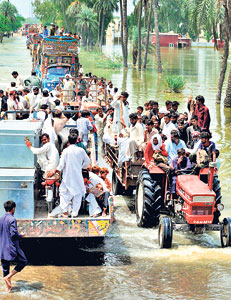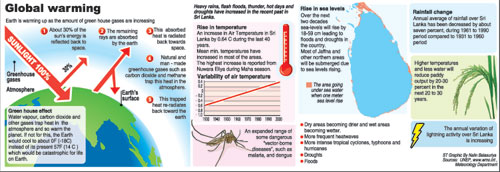From Russia’s record-breaking temperatures that have killed 15,000 people this summer to Pakistan’s floods that have affected more than 20 million, drastic changes in the climate around the world have left Sri Lanka vulnerable to extreme weather conditions, local experts have warned.
According to NASA’s Earth Observatory, around 48 massive floods, around 85 tropical storms, typhoons, heavy rains and hurricanes and more than 30 wild fires have been reported so far this year. The affected areas and countries include Sri Lanka. Other countries on the list are Madagascar, Kazakhstan, North-South Dakota, Southern Queensland, Spain, the Madeira Islands, Peru, Tanzania, Brazil, Southern China, Azerbaijan, Kentucky, North-eastern United States, Pakistan, Mexico and China-North Korea border.
 |
| R.M.S. Bandara: Regulations needed to minimise damage from landslides |
Tropical storm Laila together with torrential monsoonal rains caused heavy floods in Sri Lanka’s Southern and Western Provinces in May with at least 20 people killed while more than half a million people were affected.
Two months later, Pakistan saw the worst floods in its post-independence history with more than 1,500 people killed and around 20 million people affected. Besides an outbreak of cholera, dysentery or other diseases, aid agencies fear the floods could cause a food shortage because large areas of the country’s agriculture farmland have gone under water and become unfit for cultivation, at least for the next several months.
While Pakistan and parts of Indian-administered Kashmir were experiencing heavy downpours and floods, Russia’s southern areas faced a severe drought and forest fires, prompting Prime Minister Vladimir Putin to impose a temporary ban on grain exports. Russia is the world’s fourth largest wheat exporter and the ban threatened to increase world wheat prices.
In April-May this year, volcanic eruptions in Iceland forced the cancellation of flights in Europe and widespread disturbance in air travel across the globe.
Colombo University’s Senior Hydrogeology lecturer Dr. Ranjana Piyadasa said that given the unpredictability of the weather patterns, countries should be prepared to face extreme situations.
“Floods, droughts, thunder and lightning, landslides, sea erosion, storms and tornadoes have been there since ancient times. But the situation today is different. They are becoming more intense and more people are being affected. The extreme weather conditions are unpredictable,” he said.
He said the changed rain fall patterns of Sri Lanka with heavy showers instead of average rains may result in geological changes.
“We see there is a slight delay in monsoon patterns and longer drought periods. But when the rains come, they are severe but end in one or two days, causing floods in many parts of the country. The rains fall on the ground that has been dried up by prolonged drought conditions which also affect the ground water levels. So when there is a heavy rainfall, there will be more surface runoff and less infiltration. It is, therefore, important to start rainwater harvesting as there will be a lot of inland water resources drying up due to the intensity of droughts,” he said.
Dr. Piyadasa urged the government to pay more attention to the drainage system in cities and towns as more heavy showers were expected in the future.
 |
| Dr. Ranjana Piyadasa: Sri Lanka’s weather patterns are changing |
Another area of concern expressed by Dr. Piyadasa is the recurrent problem of landslides. He said landslides were also caused by human activities. The hydrogeology expert said farmers and planters resorting to cash crops instead of time-tested environment-friendly crops was one of the causes of landslides.
The cash crops might bring more money but they also brought more misery, he said.
“We see small-scale tea planters are shifting to potato cultivation for quick economic benefits. Tea plantation has a water management system and do not require much water. Therefore the water absorption is less and it is less likely to contribute to landslides,” he said
Sarath Premalal, a senior meteorologist at the Meteorology Department, said temperatures around the country had increased by one degree, except in Nuwara Eliya where the rise was about two degrees.
He said the one degree increase in the temperature did not seem alarming but it could disturb weather conditions in the country and gradually affect agriculture, water resources and the people’s health.
According to Mr. Premalal, hot days are increasing and cold/frosty days in the hill country are decreasing.
Met Department records show that between 1961 and 1983, the number of hot days per year – with the temperature reaching 35 degrees Celsius -- was around 50. But since 1985, the department has been recording more than 100 such hot days per year.
He said the decrease in annual rainfall would affect the hydro-catchments areas and would have an impact on the water resources of Sri Lanka. “Of the total water received from heavy rainfall 37 percent goes as surface runoff while 63 percent is retained. Of this, 59 percent evaporates,” he said.
Mr. Premalal said the Meteorology Department is carrying out studies on the impact of the present climate change and extreme weather conditions on Sri Lanka.
 |
| Pakistani flood-affected families travel through water as they return home to Bassera village in Punjab province as floodwaters recede. AFP |
“While infectious and water-borne diseases break out during floods, abnormal hot days can affect those suffering from blood pressure or hypertension,” he said. The extreme or unpredictable weather could also affect the ecosystems, including mangroves and coral reefs and could even result in several species becoming extinct.
“Low-lying coastal systems are vulnerable to a rise in sea levels caused by the global climate change. Coastal areas of islands like Sri Lanka are likely to be erased from the map in the long run,” he said.
R.M.S. Bandara, head of the Landslide Division of the National Building Research Organization, said unpredictability of the rain pattern meant that there was no particular period or time for landslides to occur.
“Landslides are caused by natural and human activities; those who reside near hill areas do not follow proper cutting measures. As a result, heavy rains that last for a few hours can easily cause landslides and soil erosion,” he said.
According to him, some 12,500 sq km of Sri Lanka’s 65,000 sq km total land is landslide prone with Badulla, Nuwara Eliya, Ratnapura, Kegalle, Kandy, Matale, Kalutara, Galle, Matara and Hambantota being identified as vulnerable districts.
He said that deforestation, cultivation on slopes, non-engineered construction and improper drainage systems were some of the reasons for the increasing number of landslides.
Mr. Bandara called on the government to introduce regulations that will make consultation with the NBRO a necessary condition for constructing houses or buildings in vulnerable areas.
Dr. Ranjith Punyawardena, Climatology Head of the Agriculture Department, said they were highly concerned about the impact of prolonged drought conditions and sudden heavy rainfalls on agriculture. The extreme weather could reduce the quality and quantity of agricultural products, he said.
“Floods can destroy crops especially in the Western slopes and the Eastern Province. If there is an increase in the average temperature, it may affect the pollenisation process, contributing to a low yield of agriculture products,” he said adding that the paddy, maize, green grams, grams and chillies cultivations would be hit hard by the temperature rise.
However, he also warned that even highland crops could also be affected if the drought prolonged.
He said the quality of potatoes and hill country vegetables such as lettuce, cabbage, beetroot, cauliflower, knol-khol, beans, tomato and capsicum will go down if the temperature kept increasing.
By way of a solution, Dr. Punyawardena said that irrigation water retention areas should be improved and the cultivation of food crops should be increased as a food security measure to face any global food shortage caused by the global climate change.
|





